Your website is the seminal mouthpiece of the business. And content architecture plays the single most decisive role in the kind of experience users get. The first 5 seconds of experience in the website is instrumental to conversion. It can either make or break your reputation.
After all, the content layout in your business website reflects your vision and goals. An optimised look communicates authority and expertise and drives up your sales machine. So, check out this comprehensive guide to content architecture and its importance in today’s marketing.
What is Content Architecture?
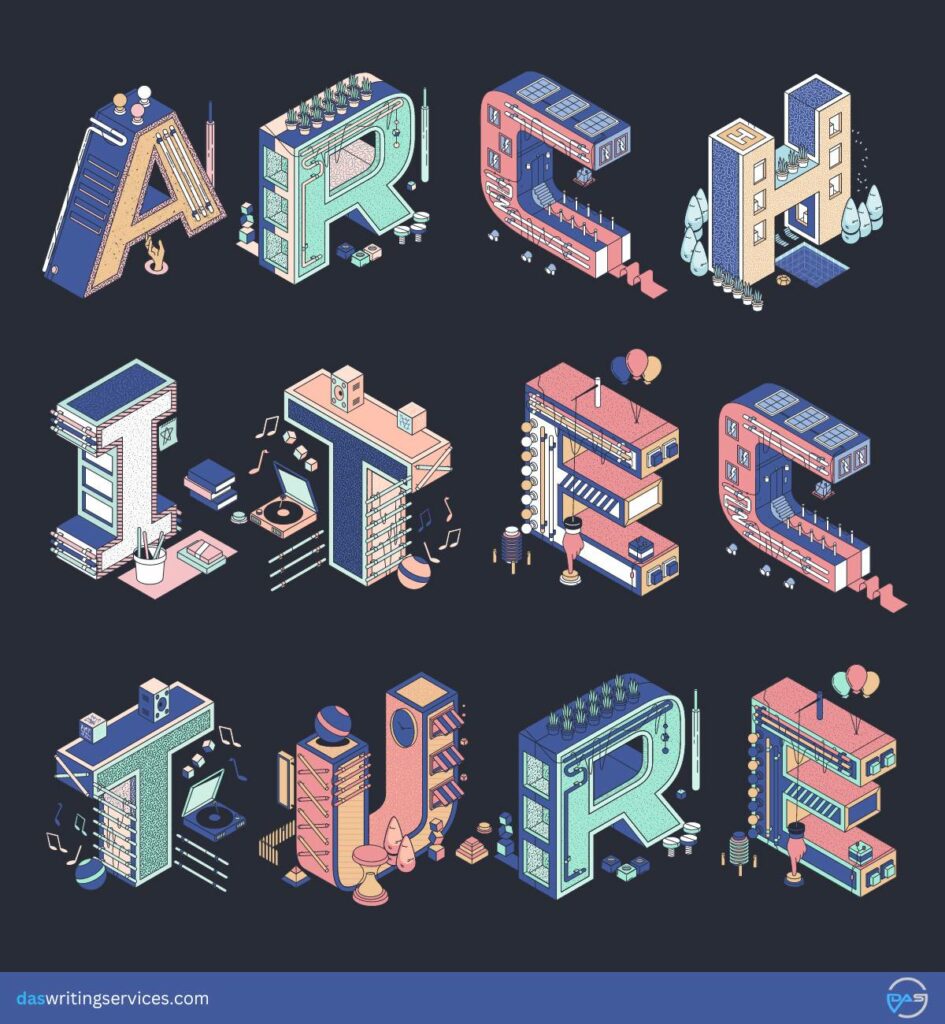
Essentially, content architecture is a process by which information is arranged and distributed in a web content or article. The way information is spread may seem like a pretty generic task. However, it plays a decisive role in the reading experience and develops the reader’s perception of your content.
The user experience of content is crucial to establish a good rapport with your target audience. If the information in your blog is organised randomly, it will frustrate the reader and will result in creating a negative impact on your business.
How to Create an Impactful Content Architecture?
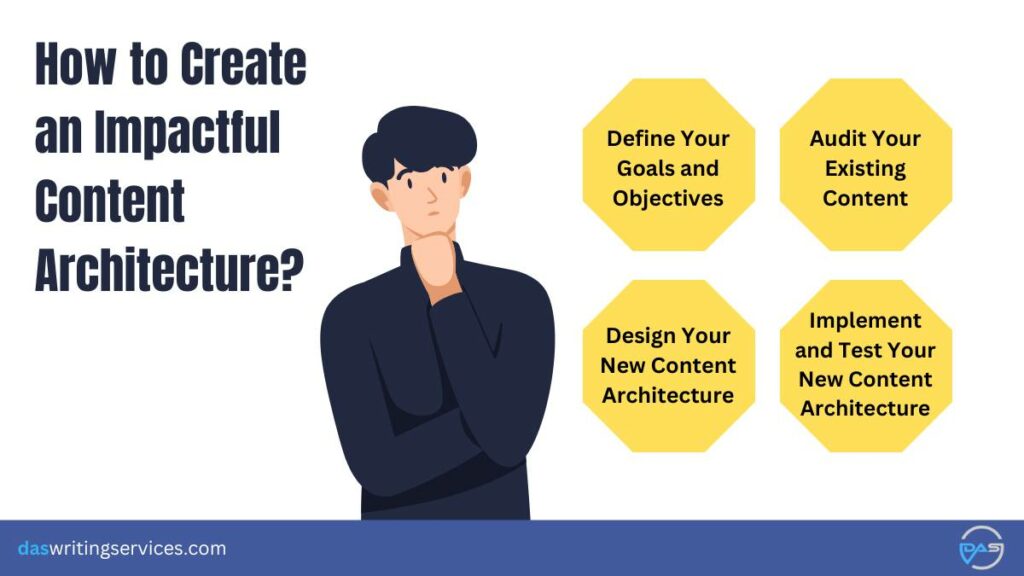
Creating an impactful content architecture requires a systematic and strategic approach. Result-oriented planning helps you chalk out the correct strategy to manage the information in a logical manner. Here are some steps you can follow:
1. Define your goals and objectives:
Before you start designing the content, decide on a clear vision of what you want to achieve with it. What are your business goals? Who is your target audience? What are their needs and pain points? How do you want them to interact with your content? These questions will help you define the purpose and scope of your information organisation.
2. Audit your existing content:
If you already have some content on your website or other platforms, you need to evaluate its quality, relevance, and performance. You can use tools such as Google Analytics, Screaming Frog, or SEMrush to analyse metrics such as traffic, bounce rate, conversion rate, etc. You can also use tools such as Card Sorting or Tree Testing to test how your users perceive and navigate through your existing content. Based on the results of your audit, you can identify the strengths and weaknesses of your current content architecture and decide what to keep, update, or delete.
3. Design your new content architecture:
Based on your goals and objectives, you can design new content that suits your needs. You can use practices such as Mind Mapping or consider using a wireframe with key pointers to stay on top of the requirements. To visualise and sketch out the structure and layout of your new content get a prototype and evaluate the utility of the structure. You can also use tools such as Content Modeling or Content Inventory to define the types and attributes of your new content.
4. Implement and test your new content architecture:
Once you have designed your new content, you need to implement it on your website or other platforms. You can use tools such as WordPress, Drupal, or Hygraph to create and manage your new content. The next step is to test and validate your new content architecture with your users and stakeholders. You can use tools such as User Testing, A/B Testing, or Heatmap Analysis to collect feedback and measure the effectiveness of your new content architecture.
Why Should You Use Content Architecture?
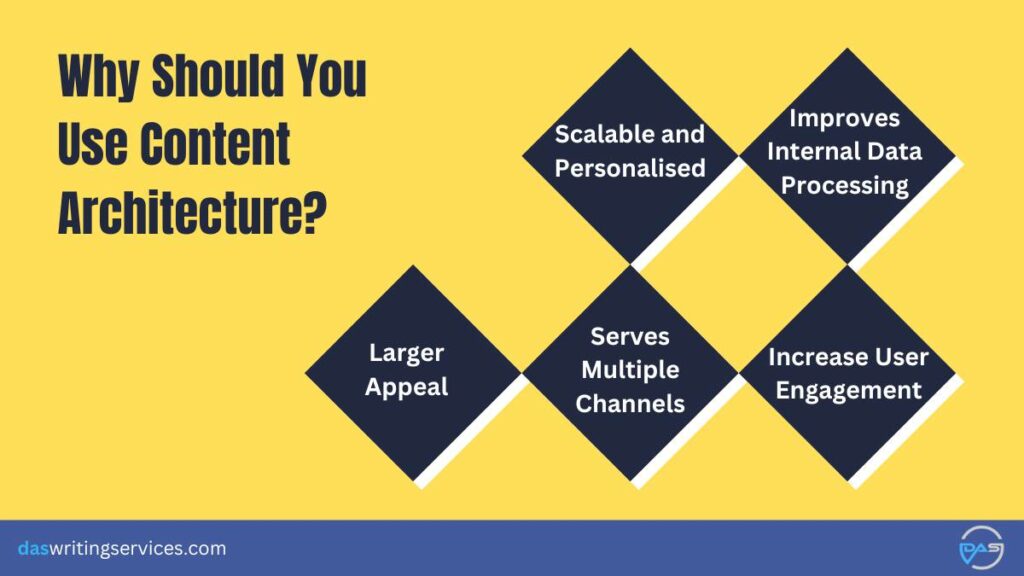
Taking a structured approach towards information distribution is instrumental to the perception of your business. In the long run, a planned content structure empowers a business to communicate its ideas and vision more clearly and in a lucid manner. It leaves a positive impact on the overall brand image to create a distinguished identity in the market.
Here are the Top 5 Benefits associated with content architecture:
1. Scalable and Personalised
The content on your website is a mirror through which the world perceives your business. A rational flow of information means you can cut the fluff or introduce new information to your content from time to time without having to completely redo the content and the website layout. It gives you the scope to personalise the content as per the requirements to boost website engagement.
2. Improves Internal Data Processing
Structured presentation of information is not only beneficial for visitors and clients but it also boosts internal communication and data processing. Using the proper flow of information in your content reduces training time and enables human resource optimisation.
They also help you fetch crucial data and information in a comprehensible manner. Therefore, it improves internal operations and prepared for the blockchain ecosystem.
3. Larger Appeal
Incoherent messaging can significantly alter the engagement of your website and content. If a visitor cannot find the required information quickly, they tend to bounce away – affecting the session time. This creates a negative impact on the authority of your website.
Conversely, having structured information with the key pointers emphasised, helps users navigate through the site quickly and increases the utility to a larger audience.
4. Serves Multiple Channels
Having access to customisable and SEO-optimised content empowers you to use your content on multiple online platforms. Be it on your own website or LinkedIn, architectured content is suitable for cross-platform usage and emulates your vision and mission to the target group.
5. Increase User Engagement
Logical flow and swift presentation of information create an immersive user experience which delivers an engaging experience to the visitors and improves your brand awareness. A customised User Experience has a lot of potential in a competitive market. It allows you to get an edge on your competitors and create your own individual niche in the market.
Examples of Content Architecture
Keeping in mind the several benefits of using structured content on your website and third-party marketplaces, here are some common practices that you can implement in your content. We have discussed the contemporary practice of using content architecture in modern websites below.
1. Headless CMS:
A headless CMS is a content management system that separates the content layer from the presentation layer. This allows the content to be stored and managed in a centralized repository, and delivered to any channel or device via APIs. A headless CMS enables a more agile and efficient content creation and delivery process, as well as better performance and security for the website.
2. Content Models:
A content model is a representation of the types of content associated with a website and their attributes and relationships. They help to define the structure, semantics, and rules for the content, as well as the metadata and taxonomy that are needed to organize and categorise it. A content model also facilitates the reuse and repurposing of content across different channels and devices.
3. Wireframes:
A wireframe is a visual guide that shows the layout and arrangement of the content elements on a web page. A wireframe helps to communicate the hierarchy, functionality, and navigation of the page, as well as the user interface design and user experience. Check out this screenshot from our blog below to learn how we use Table of Contents as a wireframe to help navigate the users in long-form blogs.
Content Architecture Vs Information Architecture
Both the phrase content and information architecture sound just the same. While there are similarities like both require a creative as well as scientific approach to easeful communication, there is a slight difference between the two. Content architecture is a broad term that covers diverse platforms and ecosystems. Check out the key differences between the two:
| Content Architecture | Information Architecture |
| Covers a variety of platforms both online and offline. | Deals with how information is presented on a particular web page or content. |
| Serves to streamline internal operations and smooth the flow of information. | The Target group is an audience and User Experience. |
| Uses SEO alongside content modelling to ensure clear navigation. | Uses SEO to optimise information distribution. |
| Used to reflect brand identity and vision. | Used to provide information on a particular topic. |
| Benefits include customizability for cross-platform implementation. | Benefits include greater traffic and improved session times. |
Having learned all about content architecture, let us quickly look into its importance for digital marketing operations. They help you optimise user engagement for the target group of the audience. It also promotes easy-to-find helpful content on the SERP that creates an overall impact on your business persona and online performance. So, get your website content audited today to make sure you are getting the most out of it!
Frequently Asked Questions
1. What is the role of a content architect?
A content architect performs the following duties to organise content in a logical manner so as to increase readability and improve the overall brand image of the business.
2. What are the 5 types of content?
Most web-based content is categorised in either of the 5 categories i.e. blogs, social media, email content, copywriting and video content.
3. Will content architecture increase my sales?
Organising the content in a logical manner only allows you to deliver information in a structured and comprehensible manner. It helps you retain and engage your visitors on the website – which leaves an overall positive impact that will drive up your sales.
4. How can content architecture improve my website?
Using content architecture can significantly improve the UX of a website and improve its rankings. A meaningful structure of your content allows you to retain more users and reduce bounce rates. It all generates stable traffic in your website which then can improve the performance and lead generation of your website.
5. Which type of content needs architecture?
Any type of content that is long-form in nature and deals with multiple pointers can get benefited from information architecture.

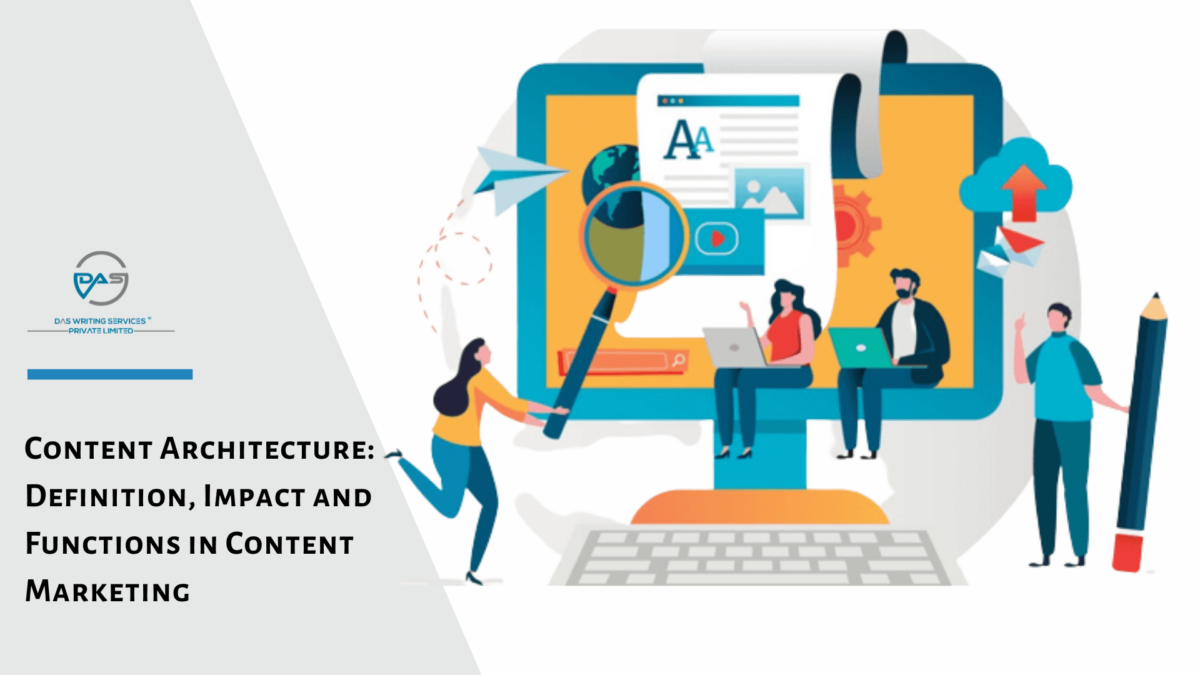
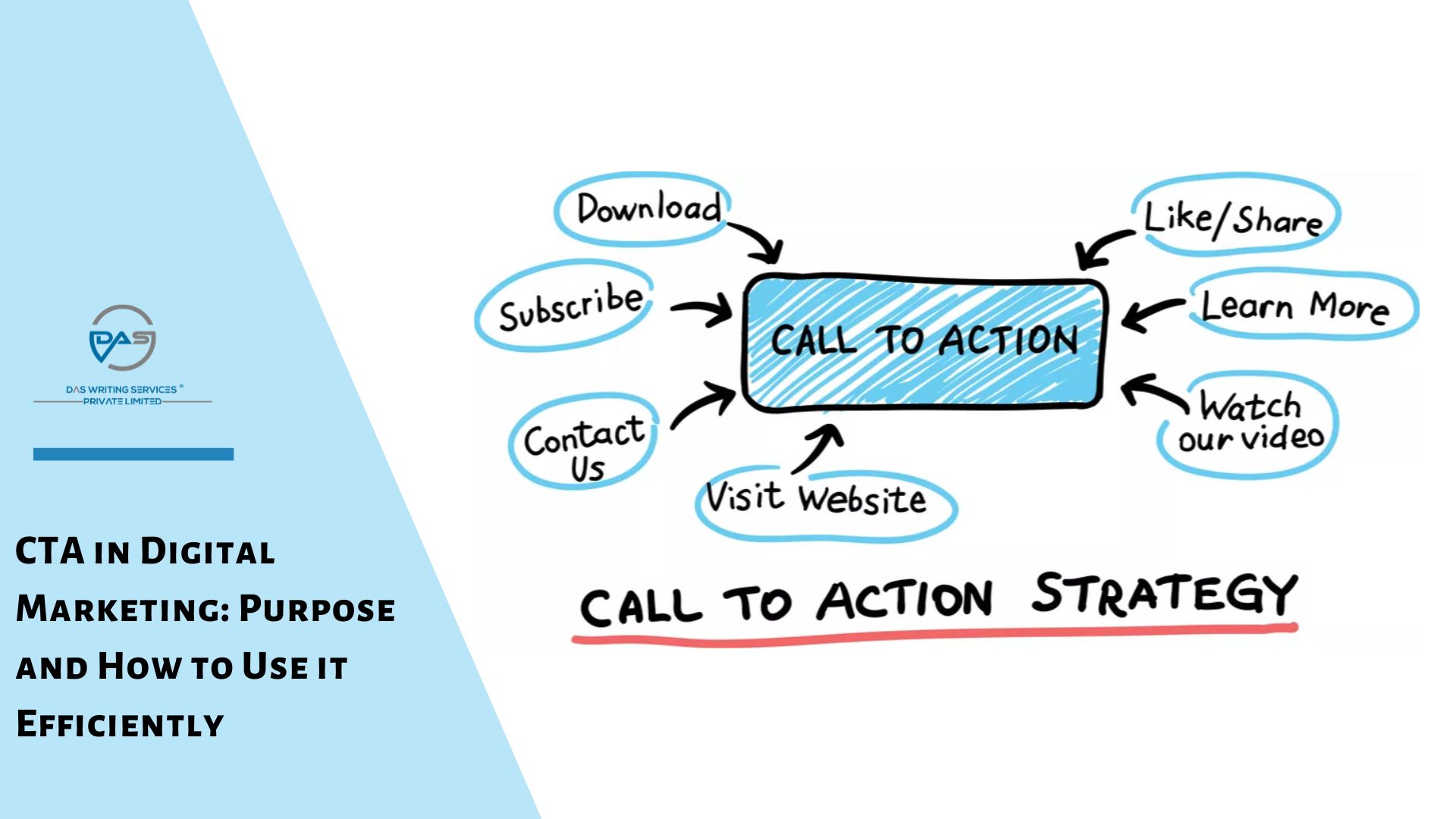


Leave a comment